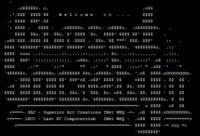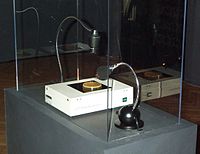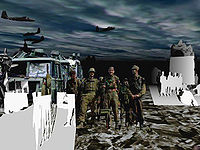- New media art
-
New media art is a genre that encompasses artworks created with new media technologies, including digital art, computer graphics, computer animation, virtual art, Internet art, interactive art, computer robotics, and art as biotechnology. The term differentiates itself by its resulting cultural objects and social events, which can be seen in opposition to those deriving from old visual arts (i.e. traditional painting, sculpture, etc.). This concern with medium is a key feature of much contemporary art and indeed many art schools and major Universities now offer majors in "New Genres" or "New Media".[1] New Media Art often involves interaction between artist and observer.
New Media concerns are often derived from the telecommunications, mass media and digital modes of delivery the artworks involve, with practices ranging from conceptual to virtual art, performance to installation.[2]
Contents
History
The origins of new media art can be traced to the moving photographic inventions of the late 19th century such as the zoetrope (1834), the praxinoscope (1877) and Eadweard Muybridge's zoopraxiscope (1879).
During the 1960s the development of then new technologies of video produced the new media art experiments of Nam June Paik, Wolf Vostell and A. Michael Noll, and multimedia performances of Fluxus. At the end of the 1980s the development of computer graphics, combined with real time technologies then in the 1990s with the spreading of the Web and the Internet favored the emerging of new and various forms of interactivity Lynn Hershman Leeson, David Rokeby, Don Ritter, Perry Hoberman, telematic art Roy Ascott, Internet Vuk Ćosić, Jodi, virtual and immersive art Jeffrey Shaw, Maurice Benayoun and large scale urban installation Rafael Lozano-Hemmer.
Simultaneously advances in biotechnology have also allowed artists like Eduardo Kac to begin exploring DNA and genetics as a new art medium.
Contemporary New Media Art influences on new media art have been the theories developed around hypertext, databases, and networks. Important thinkers in this regard have been Vannevar Bush and Theodor Nelson, whereas comparable ideas can be found in the literary works of Jorge Luis Borges, Italo Calvino, and Julio Cortázar. These elements have been especially revolutionary for the field of narrative and anti-narrative studies, leading explorations into areas such as non-linear and interactive narratives. A contemporary timeline of media art can be found here.[3]
Themes
Maurizio Bolognini's programmed machines (Computer sigillati series, 1992): hundreds of computers have been producing endless flows of random images.[4]
In the book New Media Art, Mark Tribe and Reena Jana named several themes that contemporary new media art addresses, including computer art, collaboration, identity, appropriation, open sourcing, telepresence, surveillance, corporate parody, as well as intervention and hacktivism.[5] In the book Postdigitale,[6] Maurizio Bolognini suggested that new media artists have one common denominator, which is a self-referential relationship with the new technologies, the result of finding oneself inside an epoch-making transformation determined by technological development. Nevertheless New Media Art does not appear as a set of homogeneous practices, but as a complex field converging around three main elements: 1) the art system, 2) scientific and industrial research, and 3) politico-cultural media activism. There are significant differences between scientist-artists, activist-artists and technological artists closer to the art system, who not only do have different training and technocultures, but also different artistic production.[7] This should be taken into account in examining the several themes addressed by New Media Art.
Non-linearity can be seen as an important topic to new media art by artists like Bill Viola who explores the term as an approach to looking at varying forms of digital projects. This is a key concept since people acquired the notion that they were conditioned to view everything in a linear and clear-cut fashion. Now, art is stepping out of that form and allowing for people to build their own experiences with the piece. People always ask, "What is the difference between non-linearity and randomness?" Non-linearity describes a project that has freedom with certain parameters, whereas randomness has freedom and no boundaries whatsoever. Non-linear art usually requires the participation of an audience to reveal its non-linearity while random art, more-or-less, acts on its own. When looking at Public Secrets, one can see this piece as non-linear due to ideas stressed by people like Viola. In doing so, viewers can understand another theme in the many forms of new media art. The participatory aspect of new media art, which for some artists has become integral, emerged from Allan Kaprow's 'Happenings'.
The inter-connectivity and interactivity of the internet, as well as the fight between corporate interests, governmental interests, and public interests that gave birth to the web today, fascinate and inspire a lot of current New Media Art.
Many new media art projects also work with themes like politics and social consciousness, allowing for social activism through the interactive nature of the media. Some examples include Sharon Daniel's Public Secrets, a site that shows oppression and struggles behind the prison system in America; Applied Autonomy's Terminal Air, a site that demonstrates the practices of United States Central Intelligence Agency's extraordinary rendition program; Beyondmedia Education, a non-profit organization that collaborates with under-served women, youth, and communities to create and distribute media arts on social justice topics including gender violence and school safety; and Michael Mandiberg's The Oil Standard, a Firefox plugin that shows all prices of online products in the cost of barrels of crude oil.
One of the key themes in new media art is to create visual views of databases. Pioneers in this area include Lisa Strausfeld and Martin Wattenberg.[8] Database aesthetics holds at least two attractions to new media artists: formally, as a new variation on non-linear narratives; and politically as a means to subvert what is fast becoming a form of control and authority.
Presentation and preservation
As the technologies used to deliver works of new media art such as film, tapes, web browsers, software and operating systems become obsolete, New Media art faces serious issues around the challenge to preserve artwork beyond the time of its contemporary production. Currently, research projects into New media art preservation are underway to improve the preservation and documentation of the fragile media arts heritage (see DOCAM - Documentation and Conservation of the Media Arts Heritage).
Methods of preservation exist, including the translation of a work from an obsolete medium into a related new medium,[9] the digital archiving of media (see Internet Archive), and the use of emulators to preserve work dependent on obsolete software or operating system environments.[10][11]
Types
The term New Media Art is generally applied to disciplines such as:
- Artistic computer game modification
- Ascii Art
- Bio Art
- Computer art
- Digital art
- Digital poetry
- Tradigital art
- Electronic art
- Evolutionary art
- fax art
- Generative art
- Glitch Art
- Hacktivism
- Hypertext
- Information art
- Interactive art
- Internet art
- Motion graphics
- Net art
- Performance art
- Radio art
- Robotic art
- Software art
- Sound art
- Systems art
- Telematic art
- Video art
- Virtual art
New media artists
- Miguel Álvarez-Fernández
- Carlos Amorales
- Cory Arcangel
- Roy Ascott
- Maurice Benayoun
- Jean-Jacques Birgé
- Maurizio Bolognini
- Oleg Buryan
- Micha Cárdenas
- Janet Cardiff
- Thomas Charvériat
- Brody Condon
- Critical Art Ensemble
- Sharon Daniel
- Liu Dao
- Char Davies
- Ronald Davis
- Heiko Daxl
- Erwin Olaf
- Electronic Disturbance Theater
- David Em
- Masaki Fujihata
- Mary Flanagan
- Floating Point Unit
- Furtherfield
- Ken Feingold
- Ingeborg Fülepp
- Ken Goldberg
- Peter Benjamin Graham
- greyworld
- Phil Hansen
- Lynn Hershman
- Perry Hoberman
- Barbara Januszkiewicz
- Carsten Nicolai
- Marc Horowitz
- G.H. Hovagimyan
- Kenneth Tin-Kin Hung
- Ryoji Ikeda
- Toshio Iwai
- Junichi Kakizaki
- Allan Kaprow
- KMA
- Knowbotic Research
- Aaron Koblin
- Myron Krueger
- Ryota Kuwakubo
- Antoinette LaFarge
- Roy LaGrone
- Steve Lambert
- Golan Levin
- Teddy Lo
- Rafael Lozano-Hemmer
- Marita Liulia
- Machfeld
- John Maeda
- Judy Malloy
- Sergio Maltagliati
- Michael Mandiberg
- Lev Manovich
- Cathy Marshall
- Eva and Franco Mattes
- Elle Mehrmand
- Bjørn Melhus
- Yucef Merhi
- Christian Moeller
- Manfred Mohr
- Francesco Monico
- Joshua Mosley
- Michael Naimark
- Joseph Nechvatal
- Kingsley Ng
- Graham Nicholls
- Nsumi
- Marisa Olson
- Randall Packer
- Nam June Paik
- Zaven Paré
- Eric Paulos
- Melinda Rackham
- Ken Rinaldo
- Don Ritter
- Finn Robertson
- David Rokeby
- Studio Roosegaarde
- Ryder Ripps
- Jason Salavon
- Charles Sandison
- Marie Sester
- Jeffrey Shaw
- Alexei Shulgin
- Antoine Schmitt
- Scott Snibbe
- Ubermorgen
- Camille Utterback
- Bill Viola
- Wolf Vostell
- Lee Walton
- Martin Wattenberg
- Gillian Wearing
- Noah Wardrip-Fruin
- Guillermo Gómez-Peña
- Augusto Boal
- System D-128
- Yuri Ono
New media curators
- Klaus Biesenbach
- Sarah Cook
- Barbara London
- Christiane Paul
- Won-il Rhee
- Lawrence Rinder
- Julian Stallabrass
- Mark Tribe
- Peter Weibel
See also
- Artmedia
- Aspect magazine
- Center for Art and Media Karlsruhe
- CRUMB - Curatorial Resource for Upstart Media Bliss
- Digital art
- Digital Media
- Digital puppetry
- DOCAM: Documentation and Conservation of the Media Arts Heritage
- Electronic art
- Electronic Language International Festival
- Experiments in Art and Technology
- Interactive film
- Interactive Media
- Intermedia
- Net.art
- New Epoch Notation Painting
- New Media art festivals
- New media artist
- New Media Caucus
- New media art journals
- New media art preservation
References
- ^ "Academy of Art New Media Degree"
- ^ Many universities and colleges offer program of study in Media Arts
- ^ Hoetzlein, 2009. Timeline of 20th c. Art and Media
- ^ S. Solimano (ed.) (2005), Maurizio Bolognini. Programmed Machines 1990-2005, Genoa: Villa Croce Museum of Contemporary Art, Neos, ISBN 8887262470.
- ^ Mark Tribe, Reena Jana (2007), New Media Art, Introduction, Rome: Taschen, ISBN 9783822825372
- ^ Maurizio Bolognini (2008) (in Italian), Postdigitale, Rome: Carocci Editore, ISBN 9788843047390, http://www.bolognini.org/bolognini_PDIG.htm
- ^ See also Maurizio Bolognini, "From interactivity to democracy. Towards a post-digital generative art", Artmedia X Proceedings. Paris, 2010.
- ^ Bulajic, Viktorija Vesna (2007). Database aesthetics: art in the age of information overflow. University of Minnesota Press.
- ^ Digital Rosetta Stone
- ^ Preserving the Rhizome ArtBase, a report by Richard Rinehart for Rhizome.org
- ^ Cultural Heritage as a Mediation of Digital Culture, a report by Nina Zschocke; Gabriele Blome; Monika Fleischmann for netzspannung.org
Further reading
- Wardrip-Fruin, Noah and Nick Montfort, ed (2003). The New Media Reader. The MIT Press. ISBN 0-262-23227-8.
- Vannevar Bush (1945). "As We May Think" online at As We May Think – The Atlantic Monthly
- Roy Ascott (2003). Telematic Embrace: Visionary Theories of Art, Technology, and Consciousness (Ed.) Edward A. Shanken. Berkeley: University of California Press. ISBN 978-0-520-21803-1
- Barreto, Ricardo and Perissinotto, Paula “the_culture_of_immanence”, in Internet Art. Ricardo Barreto e Paula Perissinotto (orgs.). São Paulo, IMESP, 2002. ISBN 85-7060-038-0.
- Jorge Luis Borges (1941). "The Garden of Forking Paths." Editorial Sur.
- Nicolas Bourriaud, (1997) Relational Aesthetics, Dijon: Les Presses du Réel, 2002, orig. 1997
- Christine Buci-Glucksmann, "L’art à l’époque virtuel", in Frontières esthétiques de l’art, Arts 8, Paris: L’Harmattan, 2004
- Christine Buci-Glucksmann, La folie du voir: Une esthétique du virtuel, Galilée, 2002
- Sarah Cook & Beryl Graham, Rethinking Curating: Art After New Media, Cambridge, Mass.: MIT Press, 2010. ISBN 978-0-262-01388-8.
- Sarah Cook, Verina Gfader, Beryl Graham & Axel Lapp, A Brief History of Curating New Media Art - Conversations with Curators, Berlin: The Green Box, 2010. ISBN 978-3-941644-20-5.
- Sarah Cook, Verina Gfader, Beryl Graham & Axel Lapp, A Brief History of Working with New Media Art - Conversations with Artists, Berlin: The Green Box, 2010. ISBN 978-3-941644-21-2.
- Fleischmann, Monika and Reinhard, Ulrike (eds.). Digital Transformations - Media Art as at the Interface between Art, Science, Economy and Society online at netzspannung.org, 2004, ISBN 3-934013-38-4
- Monika Fleischmann / Wolfgang Strauss (eds.) (2001). Proceedings of »CAST01//Living in Mixed Realities« Intl. Conf. On Communication of Art, Science and Technology, Fraunhofer IMK 2001, 401. ISSN 1618–1379 (Print), ISSN 1618–1387 (Internet).
- Gatti, Gianna Maria. (2010) The Technological Herbarium. Avinus Press, Berlin, 2010 (edited, translated from the Italian, and with a preface by Alan N. Shapiro). online at alan-shapiro.com
- Charlie Gere, (2002) Digital Culture, Reaktion ISBN 978-1-86189-143-3
- Charlie Gere, (2006) White Heat, Cold Logic: Early British Computer Art, co-edited with Paul Brown, Catherine Mason and Nicholas Lambert, MIT Press/Leonardo Books
- Graham, Philip Mitchell, New Epoch Art, InterACTA: Journal of the Art Teachers Association of Victoria, Published by ACTA, Parkville, Victoria, No 4, 1990, ISSN 0159-9135, Cited In APAIS. This database is available on the, Informit Online Internet Service or on CD-ROM, or on Australian Public Affairs - Full Text
- Oliver Grau (2003). Virtual Art: From Illusion to Immersion (Leonardo Book Series). Cambridge, Massachusetts: The MIT Press/Leonardo Books. ISBN 0-262-07241-6.
- Oliver Grau (2007). (Ed.) MediaArtHistories. Cambridge, Massachusetts: The MIT Press/Leonardo Books. ISBN 0-262-07279-3.
- Mark Hansen, (2004) New Philosophy for New Media (Cambridge, MA: MIT Press)
- Dick Higgins, ‘Intermedia’ (1966), reprinted in Donna De Salvo (ed.), Open Systems Rethinking Art c. 1970, London: Tate Publishing, 2005
- Lopes, Dominic McIver. (2009). A Philosophy of Computer Art. London: Routledge
- Lev Manovich (2001). The Language of New Media Cambridge, Massachusetts: The MIT Press/Leonardo Books. ISBN 0-262-63255-1
- Lev Manovich, Ten Key Texts on Digital Art: 1970-2000 Leonardo - Volume 35, Number 5, October 2002, pp. 567–569
- Lev Manovich (2003. "New Media from Borges to HTML", The New Media Reader. MIT Press.
- Dominique Moulon, Tim Murray, Kristine Stiles, Derrick de Kerckhove, Oliver Grau Open Art, Maurice Benayoun, Nouvelles editions Scala, 2011, ISBN 978-235-988046-5
- Paul, Christiane (2003). Digital Art (World of Art series). London: Thames & Hudson. ISBN 0-500-20367-9.
- Robert C. Morgan, Commentaries on the New Media Arts Pasadena, CA: Umbrella Associates,1992
- Janet Murray (2003). "Inventing the Medium", The New Media Reader. MIT Press.
- Frank Popper (2007) From Technological to Virtual Art, MIT Press/Leonardo Books
- Frank Popper (1997) Art of the Electronic Age, Thames & Hudson
- Edward A. Shanken Selected Writings on Art and Technology http://artexetra.com
- Edward A. Shanken Art and Electronic Media. London: Phaidon, 2009. ISBN 978-0-7148-4782-5
- Mark Tribe and Reena Jana. New Media Art. https://wiki.brown.edu/confluence/x/Wkg
- Rainer Usselmann, (2003)"The Dilemma of Media Art: Cybernetic Serendipity at the ICA London", Cambridge, Masschusetts: The MIT Press/Leonardo Journal - Volume 36, Number 5, pp. 389–396
- Rainer Usselmann, (2002)"About Interface: Actualisation and Totality", University of Southampton
- Wands, Bruce (2006). Art of the Digital Age, London: Thames & Hudson. ISBN 0-500-23817-0.
- Whitelaw, Mitchell (2004). Metacreation: Art and Artificial Life Cambridge, Massachusetts: The MIT Press. ISBN 0-262-73176-2.
- Anne-Cécile Worms, (2008) Arts Numériques: Tendances, Artistes, Lieux et Festivals M21 Editions 2008 ISBN 2-916260-33-1.
- Youngblood, Gene (1970). Expanded Cinema. New York. E.P. Dutton & Company.
External links
- "Academy of Art New Media Degree"
- ASPECT- The Chronicle of New Media Art
- AV-arkki - AV-arkki, Distribution Centre For Finnish Media Art
- Digitalarti- New media art collaborative community
- Center for Experimental Media Arts
- Database of Virtual Art
- Department for Image Science, Danube University
- FILE electronic language international festival New Media Festival
- Glare Media Art Resources - Pioneering Media Art International Distribution
- Karlsruhe University of Art and Design - Media art and theory graduate and doctoral courses
- LEONARDO- Leonardo/The International Society for the Arts, Sciences and Technology
- LAb[au] - laboratory for architecture and urbanism
- Monoskop/log - Living archive of writings on art, culture and media technology
- Media art in Central and Eastern Europe at Monoskop wiki research
- Mediateca Media Art space
- Monoskop - collaborative wiki research on social history of media art
- Theories and definitions of media art
- Media Arts at Eastern Oregon University - innovative new media art program offering degrees in three concentrations; digital media, journalism, and film studies.
- NMC – New Media Caucus, CAA Affiliate Society
- CyLand MediaLab - new artistic laboratory created by St. Petersburg branch of National Center for Contemporary Arts, Russia
- NAMAC- The National Alliance for Media Arts and Culture
- NewMediaArtProjectNetwork: Cologne - experimental platform for art and New Media
- RHIZOME- An online resource and blog about contemporary new media artists (connected to the New Museum)
- Share - international organization supporting 'open multimedia jams' throughout the world
- SWITCH- An online journal of contemporary media culture
- Thomas Dreher: Medienkunst (with contributions on different forms of media art, in German)
- Experimenta Media Arts
- http://www.jazzvisiontrio.info
Categories:
Wikimedia Foundation. 2010.





